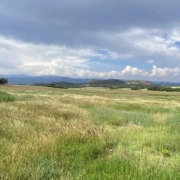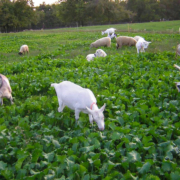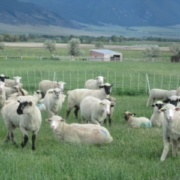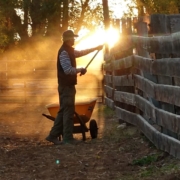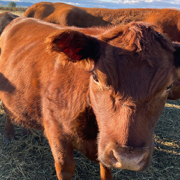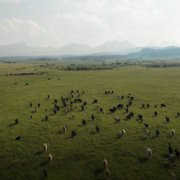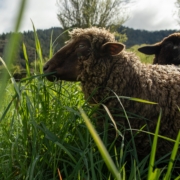Advanced Grazing, Session 4 – Adaptive Management
 Print This Post
Print This Post
By Justin Morris, NCAT Regenerative Grazing Specialist, and Lee Rinehart, NCAT Agriculture Specialist
Did you know that grazing management and driving a vehicle have a lot of similarities? While driving, you monitor the road ahead of you to know whether to turn left, turn right, speed up, slow down, or even reverse direction. You make these changes whenever conditions change, like the road curving to the left, wildlife crossing in front of you, or a vehicle suddenly stopping in front of you. And the faster you drive, the farther down the road you must monitor so you have enough time to adapt or make the necessary changes to continue driving safely and arrive at your destination. Failure to do so can result in severe if not tragic consequences. Just like driving a vehicle, adaptive grazing management requires that we monitor the condition of the livestock, plants, and soils to know whether we need to modify our management to keep everything on track.
With adaptive grazing management, there are four main steps: 1) observe; 2) implement; 3) adjust (adapt); and 4) observe. Observation involves monitoring so that you can be proactive in your grazing management decisions. Monitoring involves measuring the species composition of your fields, taking photo points to establish the initial condition of the land or even doing line transects to get an idea on how much of the soil surface is covered with desirable plants. As these monitoring records are kept and re-done in the exact same spot in subsequent years, one can see if the land is getting healthier. Aside from doing on-the-ground data collection, one can use satellite-based imagery and greenness indices to determine pasture cover over time, as well as predict future forage production. When adjustments are needed to grazing management based on the feedback coming from your monitoring data, grazing timing, duration, frequency, and intensity (stock density) can be altered instantly to ensure soil, plant, and animal health stay on track.
To get ourselves looking at the right indicators to know whether an adjustment needs to be made, we could ask ourselves the following four questions that tie to each of the four grazing dimensions:
Timing: Are livestock arriving when plants are fully recovered?
Duration: How long can livestock graze in a field/paddock while maintaining or improving plant, animal, and soil health?
Frequency: Are livestock returning before plants are fully recovered?
Intensity: How uniform is the animal impact?
 The “art” of adaptive grazing management means using our powers of observation to recognize subtle deviations to indicators of animal, plant, and soil health and then to respond appropriately and immediately by altering one or more of the four dimensions of grazing management to prevent a deviation from causing long-term damage. As this is done repeatedly, soon the art of adaptiveness becomes the art of proactiveness where changes to one or more of these four dimensions prevents the deviations that were previously observed and therefore avoided altogether. Each dimension can be altered to varying degrees to address certain situations.
The “art” of adaptive grazing management means using our powers of observation to recognize subtle deviations to indicators of animal, plant, and soil health and then to respond appropriately and immediately by altering one or more of the four dimensions of grazing management to prevent a deviation from causing long-term damage. As this is done repeatedly, soon the art of adaptiveness becomes the art of proactiveness where changes to one or more of these four dimensions prevents the deviations that were previously observed and therefore avoided altogether. Each dimension can be altered to varying degrees to address certain situations.
For example, if we observe that the livestock’s manure is runny (manure score of 1 or 2), we may need to: 1) hold off on grazing that field until the plants are more mature if the plants are in the vegetative stage; or 2) increase stock density on a more mature pasture so that livestock graze less selectively, thereby being encouraged to graze on more mature plants that have been previously avoided.
Livestock aren’t the only animals that need our consideration with adaptive grazing management. Wildlife also need to be considered as our agricultural landscapes are habitat for wildlife. While some wildlife compete with livestock for landscape resources, many of them provide valuable pest-reduction functions for domestic livestock and serve as as enhancers of plant biodiversity.
Remember, the most productive lands for livestock are usually those that are most critical for wildlife at some time of the year. So, how do we manage our landscapes for both wildlife and livestock? First, the basic rules of building soil health, as expressed in the five soil health principles, works not only for livestock but also for wildlife. Diversity is one of the principles that is especially important. You can maintain a mosaic across the landscape, which usually includes hayfields, pasture, and woodland. This will provide habitat and promote connectivity of larger expanses of grasslands between woodlands and neighboring farms. Connectivity can be enhanced with field borders, unharvested hayfields, and pastures during some period of the year, using hedgerows, buffer and filter strips, and incorporating native plants to manage fields in patches to leave varying types of structure and cover for birds and other wildlife throughout the year.
What we are managing on our agricultural landscape is a complex organism. And the practices we use to enhance diversity for sustained production work to protect and maintain wildlife habitat, as well.
Session 4 of the webinar can be viewed here.
Related ATTRA Resources:
Advanced Grazing Series – Session 1
Advanced Grazing Series – Session 2
Advanced Grazing Series – Session 3
This publication is produced by the National Center for Appropriate Technology through the ATTRA Sustainable Agriculture program, under a cooperative agreement with USDA Rural Development. ATTRA.NCAT.ORG.

